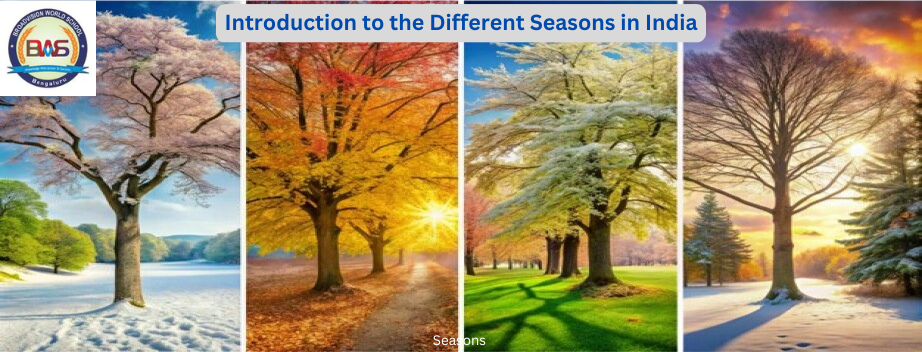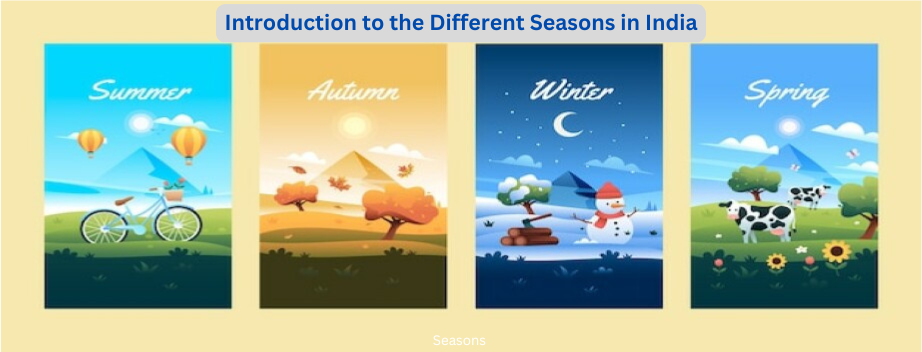Giving your child the best start in life
-
First Floor, 10A Chandos Street London New Town W1G 9LE
Get In Touch
Monday to Friday: 8.30am – 02.00pm
Saturday, Sunday: Close
Email: user@domainname.com
Phone: +44 (0) 207 689 7888

India is a land of diverse seasons, each bringing its own colors, flavors, and unique experiences. Just like how a movie has different scenes, life too has various seasons that change throughout the year. We experience five main seasons Seasons in India: Spring, Summer, Monsoon, Autumn, and Winter. Each season is special in its own way, offering us different foods to enjoy, clothes to wear, and exciting activities to do.
Why are these Seasons in India important? Well, they shape our daily lives and help nature do its job too! Seasons affect the weather, the types of food we grow and eat, and how we dress. Learning about them can help us appreciate the changes around us and adapt to them in the best way possible.
Let’s explore the different seasons in India and what makes each of them so special!

Spring in India, called Vasant Ritu, is a season full of life and color. It usually lasts from March to April. During this time, the weather becomes pleasant, neither too hot nor too cold. Flowers bloom everywhere, and trees grow new leaves after the cold winter. People celebrate festivals like Holi, the festival of colors, to welcome the beauty of spring. It is a time when nature wakes up, and animals are more active too. Many crops, like wheat, are harvested during this season.
During spring, nature gives us a variety of colorful fruits and vegetables. Some popular fruits include strawberries, mangoes, and melons. Vegetables like peas, carrots, and spinach are fresh and plentiful during this season.
In spring, it’s best to eat light and fresh foods. Try to include more salads, fresh fruits, and vegetables in your diet. Foods like yogurt and green smoothies are perfect for keeping your body cool and hydrated as the weather gets warmer.
Spring is neither too hot nor too cold, so wearing light clothes such as cotton dresses and shirts is perfect. It’s a good idea to layer your clothing because mornings might still be a bit chilly while afternoons are warm.
Spring is a great time to enjoy outdoor activities. You can fly kites, ride bicycles, or simply play with your friends in the garden. It’s also the perfect time for nature walks and bird watching because animals and plants are very active.
Grishma Ritu, or summer, lasts from May to June, and it is the hottest season in India. The sun shines very brightly, and in many places, temperatures rise above 40°C. People often drink lots of water, eat cool fruits like mangoes, and stay indoors to avoid the heat. In the deserts, like in Rajasthan, it’s extremely hot, while coastal areas are humid. However, in the mountains, the weather is much cooler, and people go there to escape the heat.
Summer brings a variety of juicy fruits that help you stay cool. Some popular fruits are watermelons, mangoes, and cucumbers. Vegetables like tomatoes, bottle gourd, and bitter gourd are also commonly available.
In the summer, it’s important to eat foods that keep you hydrated. Water-rich fruits like melons, cucumbers, and oranges are excellent choices. It’s best to avoid spicy and oily foods as they can make you feel even hotter.
Loose, light-colored clothes made from cotton are ideal for summer. Wearing a hat or cap while going outside can protect you from the harsh sunlight, and don’t forget your sunglasses!
Summer is the perfect time to play water-based activities like swimming or having a water balloon fight with friends. You can also enjoy ice cream parties or relax in the shade with a good book.
During the hot summer months, many animals must find ways to stay cool and conserve water.
Monsoon, or Varsha Ritu, arrives in July and stays until September. This season brings heavy rains, especially to places like Kerala and the Western Ghats. Farmers depend on the rain to water their crops, making it an important season for agriculture. Rivers, lakes, and ponds fill up with water, and nature looks fresh and green. However, sometimes there is too much rain, causing floods in certain areas. People enjoy eating hot snacks like pakoras during the rainy season.
Monsoon gives us many fresh fruits like apples, pears, and pomegranates. Vegetables like bitter gourd, pumpkin, and okra are in season.
Monsoon is the time for warm, comforting foods like soups and stews. It’s also a good idea to eat steamed or boiled foods and avoid street food, as the rainy season can sometimes bring waterborne diseases.
During the monsoon, it’s important to wear quick-drying clothes like synthetic fabrics. Waterproof shoes and a raincoat or umbrella are essential when stepping outside.
Rainy days are perfect for indoor games like board games or crafting. If the rain isn’t too heavy, playing football or jumping in puddles can be a lot of fun.
Winter brings colder weather, and animals must find ways to stay warm or find food when it becomes scarce.
Sharad Ritu, or autumn, is a short season from October to November. During this time, the weather becomes cooler after the rains. The skies are usually clear and blue, and the air feels crisp. Trees start shedding their old leaves, and the surroundings change colors. In some parts of India, like West Bengal, people celebrate Durga Puja, a major festival. It’s also the time when the famous Diwali festival of lights is celebrated, marking the victory of light over darkness.
Autumn brings fruits like guavas, apples, and oranges. Vegetables like cauliflower, radish, and sweet potatoes are plentiful during this season.
During autumn, you can enjoy a balanced diet that includes warm soups, roasted vegetables, and fruits. It’s a great time for baking as well since the weather is cooler.
Light jackets and sweaters are ideal for autumn as the weather starts to get a bit chilly, especially in the evenings. Comfortable clothing that provides some warmth is perfect for this season.
Autumn is great for outdoor sports like soccer, basketball, and cricket. You can also enjoy raking up leaves and making leaf piles to jump in!
Autumn is a time of transition, and many animals start preparing for the coming winter.
The Hemant Ritu or pre-winter, comes between December and mid-January. The weather starts becoming colder, especially in the northern parts of India, but it is not as cold as winter yet. It is a pleasant time for people to enjoy outdoor activities and festivals. In rural areas, farmers prepare for the next crops. People in cities often wear light sweaters, and it’s a great time for traveling. This season is known for festivals like Guru Nanak Jayanti and Christmas.
Fruits like oranges, guavas, pomegranates, and apples are plentiful. Vegetables such as carrots, spinach, cauliflower, and radishes thrive during this time, offering plenty of nutritious options to enjoy.
This season is perfect for hearty meals like soups, stews, and roasted vegetables. Foods rich in warming spices like ginger and cinnamon, as well as traditional winter treats like sesame laddoos, provide warmth and energy.
Layered clothing works best during Hemant Ritu. Light woolens like sweaters and jackets are ideal for chilly mornings and evenings, while the midday warmth allows for lighter clothing.
Hemant Ritu is great for outdoor sports like cricket and football, morning jogs, yoga, and cycling. It’s also a perfect time for festivals, cultural events, and nature hikes, thanks to the mild weather and beautiful scenery.
Shishir Ritu, or winter, lasts from mid-January to February. It is the coldest time of the year in India, especially in the northern regions where temperatures can drop below freezing. In some places, like Kashmir and Himachal Pradesh, there is snow, making it a beautiful winter wonderland. People wear warm clothes, drink hot drinks, and use blankets to stay warm. In southern India, the winter is much milder, with cool breezes. Winter is also the season for crops like wheat and barley.
Winter is the season for citrus fruits like oranges, lemons, and grapefruits. Vegetables like carrots, beets, and spinach are in abundance.
In winter, it’s good to eat warm, hearty meals like soups, stews, and roasted vegetables. Foods rich in vitamins like citrus fruits help boost your immunity.
Winter calls for warm clothing like sweaters, jackets, and woolen hats. If you’re in a colder region, you might need gloves and scarves too.
Winter is perfect for outdoor sports like football, running, and even snowball fights if you live in snowy regions. If it’s too cold outside, indoor games like table tennis or board games are great options.
Winter brings colder weather, and animals must find ways to stay warm or find food when it becomes scarce.

At Broadvision World School, we believe in teaching children about the Seasons in India in a way that makes learning fun, engaging, and meaningful. Understanding seasons helps students connect with nature, observe changes in their environment, and appreciate how seasons influence our daily lives. Here’s how we approach the topic of seasons:
Children at Broadvision World School learn about seasons through interactive lessons. We use stories, visuals, and hands-on activities to explain how different seasons occur and how they affect the environment. For example, students might observe how trees change with the seasons or create weather charts to track daily temperatures. By learning through real-life examples, kids can better understand how each season impacts nature.
We teach the scientific reason behind the change of seasons. Using simple concepts and visuals, we explain how the Earth’s tilt and orbit around the sun cause different seasons. This helps students understand why summer is hot and winter is cold, and why these changes happen at specific times of the year.
At Broadvision, we introduce children to various activities and festivals celebrated in different seasons. Whether it’s making kites for spring, enjoying indoor games during the monsoon, or learning about the cultural festivals like Diwali in autumn and Christmas in winter, we ensure students learn the significance of each season in both fun and cultural contexts.
We emphasize how seasons affect the environment and why it’s important to care for nature. For example, during the monsoon season, students learn about water conservation, and in summer, we discuss how animals and plants adapt to extreme heat. This not only teaches them about seasons but also builds environmental awareness from a young age.
We help students observe how plants and animals respond to changing seasons. For example, they might learn about the life cycle of a tree from spring to autumn, or how animals like frogs and squirrels adapt to the seasons. This helps them understand the broader impact of seasons on living things.
At Broadvision World School, we celebrate key festivals and events that are linked to seasons. Whether it’s the arrival of spring with Holi, the harvest festivals during autumn, or the winter celebrations like Christmas, students get hands-on experience in connecting cultural celebrations with the changes in seasons.
By making lessons about Seasons in India interactive, fun, and educational, Broadvision World School helps children develop a deeper understanding of the natural world while encouraging them to appreciate and respect the environment.
Each Seasons in India is unique and offers different opportunities for us to enjoy, learn, and grow. From the fresh beginnings of spring to the cozy comfort of winter, seasons shape our daily lives. It’s important to understand how each season affects what we eat, wear, and do so we can stay healthy and happy throughout the year.
India experiences five main seasons: Spring, Summer, Monsoon, Autumn, and Winter.
Spring and autumn are generally the best seasons for outdoor activities because the weather is pleasant and not too extreme.
It’s best to avoid dark-colored and tight clothes in summer as they can make you feel hotter. Stick to light, breathable fabrics.
Citrus fruits like oranges, lemons, and grapefruits are excellent during winter as they help boost immunity.
During the rainy season, indoor games like board games, crafting, or even indoor badminton are great options. On lighter rainy days, you can enjoy playing in the puddles or playing football outside.

Comments are closed